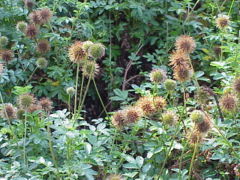Acaena
| Acaena subsp. var. | Biddy biddy, New Zealand burr, Sheep's burrs | |||||||||||||||||||||||||||||||||||||||||||||||||||||||
|---|---|---|---|---|---|---|---|---|---|---|---|---|---|---|---|---|---|---|---|---|---|---|---|---|---|---|---|---|---|---|---|---|---|---|---|---|---|---|---|---|---|---|---|---|---|---|---|---|---|---|---|---|---|---|---|---|

|
|
| ||||||||||||||||||||||||||||||||||||||||||||||||||||||
| ||||||||||||||||||||||||||||||||||||||||||||||||||||||||
Acaena is a genus of about one hundred species of perennial herbs and subshrubs in the Rosaceae, native mainly to the Southern Hemisphere, notably New Zealand, Australia and South America, but with a few species extending into the Northern Hemisphere, north to [[Hawaii|HawaiTemplate:Okinai]] (A. exigua) and California (A. pinnatifida).
The leaves are alternate, 4 - 15 cm long, and pinnate or nearly so, with 7-21 leaflets. The flowers are produced in a tight globose [inflorescence] 1 - 2 cm in diameter, with no petals. The fruit is also a dense ball of many seeds; in many (but not all) species the seeds bear a barbed arrowhead point, the seedhead forming a burr which attaches itself to animal fur or feathers for dispersal.
Several Acaena species in New Zealand are known by the common name bidibid. The word is written variously biddy-biddy, biddi-biddi, biddi-bid and a number of other variations. These names are the English rendition of the original Māori name of piripiri.[1]
| Standard Cyclopedia of Horticulture |
|---|
|
Acaena (from Greek word signifying thorn). Rosaceae. New Zealand Bur. Trailing, more or less evergreen plants used in rockwork and as ground cover under trees and between other plants. About 40 species of sub-shrubs or herbs of the southern hemisphere, allied to Agrimonia and Sanguisorba: lvs. unequally pinnate, alternate, the lfts. toothed or cut: fls. small, crowded in erect terminal spikes or heads; petals none; calyx 5-7-lobed, usually armed with spines; stamens 1-10, or even more: fr. an achene, 1 or 2 being enclosed in the hardened calyx. Acaenas are little grown in this country, but are prized in England as groundwork for dwarf spring-flowering bulbs, as trilliums; also useful in protecting native orchids and bog plants.CH
|
Cultivation
- Do you have cultivation info on this plant? Edit this section!
Propagation
Propagation is by cuttings, divisions and seeds.CH
Pests and diseases
- Do you have pest and disease info on this plant? Edit this section!
Species
- Selected specieswp
|
|
Gallery
If you have a photo of this plant, please upload it! Plus, there may be other photos available for you to add.
-
photo 1
-
photo 2
-
photo 3
References
- Standard Cyclopedia of Horticulture, by L. H. Bailey, MacMillan Co., 1963
External links
- w:Acaena. Some of the material on this page may be from Wikipedia, under the Creative Commons license.
- Acaena QR Code (Size 50, 100, 200, 500)
- ↑ Orsman, H. W. (1999). The Dictionary of New Zealand English. Auckland: Oxford University Press.
